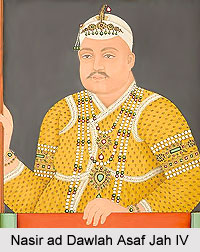 Nasir ad Dawlah Asaf Jah IV, also known as Naser Ud Daula and Nasir ad Dawlah Mir Farqunda Ali Khan Siddiqi Asaf Jah IV, was the fourth Nizam of the princely state of Hyderabad, which was the title of the ruler of Hyderabad State in India. He was born on 25th April 1794 as the eldest son of Mir Akbar Ali Khan Sikander Jah Asaf Jah III, Nizam of Hyderabad from1803 to 1829. Asaf Jah IV reigned over the princely state from the year 1829 to 1857.
Nasir ad Dawlah Asaf Jah IV, also known as Naser Ud Daula and Nasir ad Dawlah Mir Farqunda Ali Khan Siddiqi Asaf Jah IV, was the fourth Nizam of the princely state of Hyderabad, which was the title of the ruler of Hyderabad State in India. He was born on 25th April 1794 as the eldest son of Mir Akbar Ali Khan Sikander Jah Asaf Jah III, Nizam of Hyderabad from1803 to 1829. Asaf Jah IV reigned over the princely state from the year 1829 to 1857.
General C.B. Low took over the region as the Resident, during his rule. As the princely state of Hyderabad maintained a British Contingent, Nasir ad Dawlah Asaf Jah IV received a message for the payment of a huge sum of money from Lord Dalhousie. The money was due to the British East India Company for retaining the Contingent. Eventually, a new treaty was accomplished on 20th May 1853 through the payments were settled with the strength of the British Contingent.
The Contingent force ceased to be included in the Army of the Nizam of Hyderabad. It became a force which was retained by the British Government of India for the betterment of the princely state of Hyderabad.
This article is a stub. You may enrich it by adding more information to it. You can send your write-up at content@indianetzone.com



















